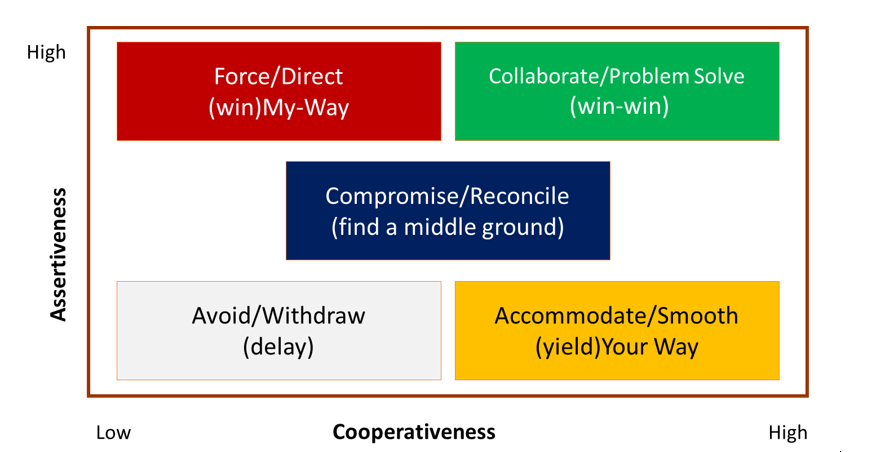Conflict can be described as a situation where the interests, goals and values of two or more parties interfere. Conflict resolution is very important in a workplace because conflict is inevitable as different stakeholders may have different and opposing priorities. Often, conflicts occur as a result of perception. Conflict is not necessarily bad and it can provide opportunities for growth and improvement depending on the method of resolution. In conflict resolution, different people make use of different methods and most of them have a preferred method that they use regularly.
Methods Of Conflict Resolution
There are five different conflict resolution approaches and these approaches include: Avoiding, Competing, Collaborating, Accommodating and Compromising.

COMPETING APPROACH (Standing your ground)
The competing approach is one in which the concerns and interests of the opposing party are completely ignored. It is also known as standing your ground to get your demands met regardless of the other party’s demands. This approach considers conflict as a win-lose situation where everything possible is done to ensure that a winner emerges and considers any concession as a sign of weakness. Experts, however advise that this approach be avoided as the disadvantages of this approach outweigh the advantages.
COMPROMISING APPROACH (Giving in)
In using the compromising approach, cooperation and assertiveness are two factors that come into play. This approach is just about one of the conflicting sides giving in to the demands of the other. It means one of the conflicting parties is willing to trade some of their needs for the sake of the other. This approach can be effective when both of the parties involved are equally powerful and not opposed to cooperation. In this approach, both parties have to carefully consider what they can and cannot live without as one of the biggest challenges of the approach is both parties may end up giving up too much and both of them will end up unsatisfied.
COLLABORATING APPROACH (Working together)
The collaborating approach is all about both sides of the conflict working together to ensure that they come up with suitable solutions that favor both sides. This approach sounds similar to the compromising approach but the compromising approach is all about trading some needs in hope that the other party will do same so a consensus can be reached. This approach is an excellent way to combine insights from different people who have the different perspectives. The challenge with this approach is that it is difficult to do as it involves taking into consideration the concerns and emotion of both parties.
ACCOMODATING APPROACH (Indulging the other party)
The accommodating approach is one of selflessness and low assertiveness. In this approach, one side of the conflict is willing to let go of anything to ensure that the conflict dies down and the other party is happy so as to preserve the relationship existing between them. This approach is suitable when one party knows that they are outmatched in power and know they are going to lose anyway or in a situation between a subordinate and a superior.
AVOIDING APPROACH (Withdrawing from the conflict)
This approach as the name implies involves withdrawing from the conflict or pretending not to know there is a conflict of interest. The goal of this approach is to avoid making any decision at any cost. This style is only used when the issues are not of serious concern, when both parties know that delaying in making a decision would not cause any challenges or when more information about the conflict is still forthcoming.

Conflict is an inevitable part of life, both personally and professionally, hence the need for ways of conflict resolution. Conflict resolution has a lot to do with one’s emotional intelligence so as to make sure that the conflict does not escalate. In resolving conflict, it is good to understand each approach of conflict resolution as they all have their appropriate uses and situations and it is helpful to know the conflict resolution approach the other party involved is using.

